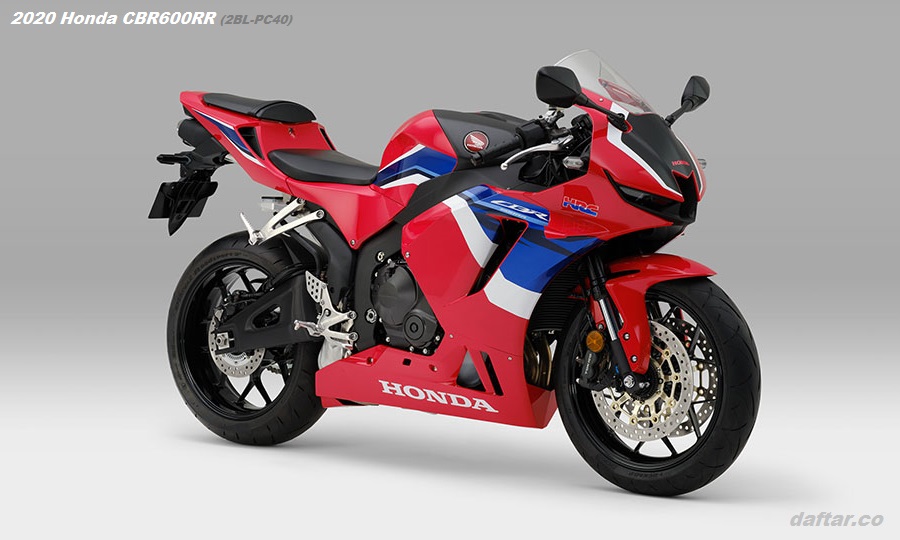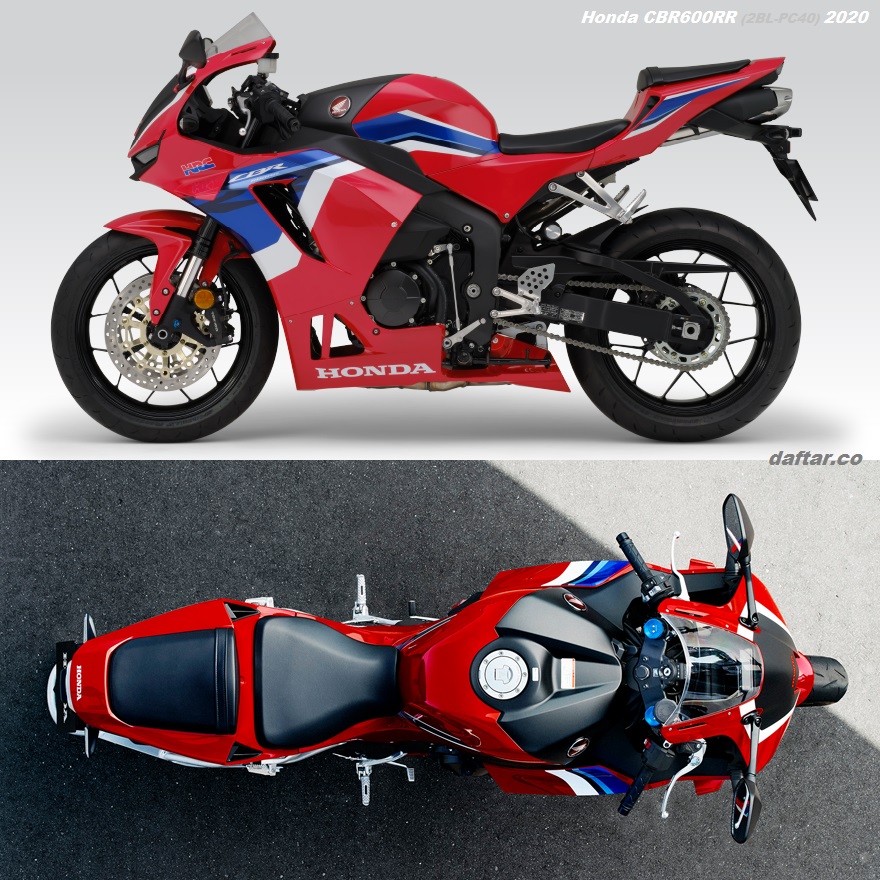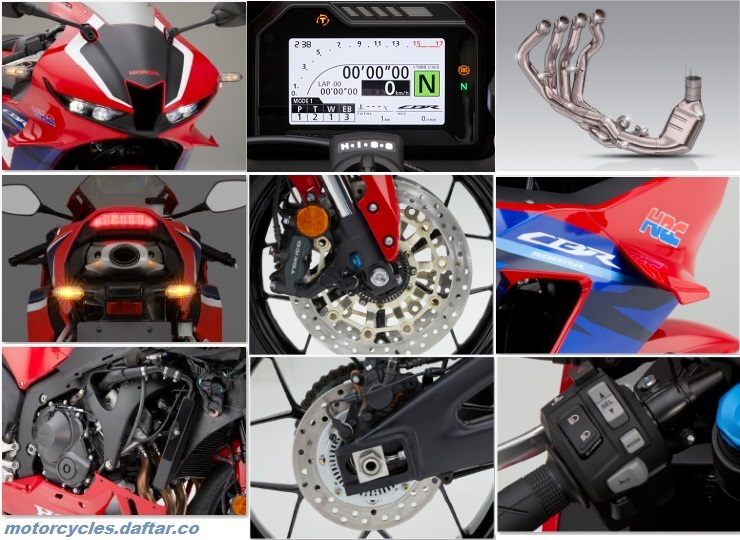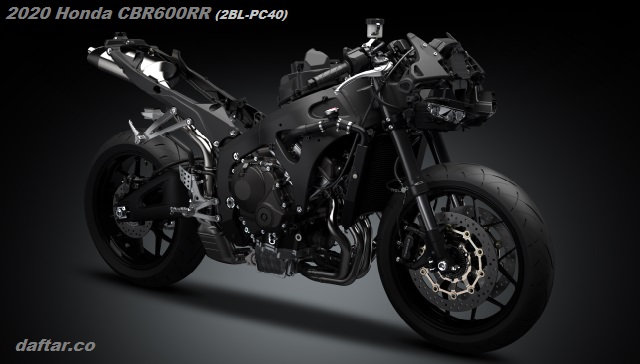New 2020 Honda CBR600RR (2BL-PC40) Specs, Photos, Price, Review
 |
| Photo of Honda CBR600RR (2BL-PC40) photo. Release date : 2020-09-25. |
Honda released a super sports model CBR600RR with improved overall performance, including high-performance water-cooled, 4-stroke, DOHC, in-line 4-cylinder 599cc engine, and the latest electronic control technology and aerodynamic performance technology on Friday, 25th of March.
The Honda CBR600RR was developed as a super sports model so that you can enjoy the high potential as a base model for production races with commercial vehicles in your daily life. The high output and easy-to-use output characteristics and agile handling, which are the characteristics of the conventional model, have been further refined to achieve both excellent power performance in circuit driving and ease of handling on public roads such as winding. We pursued “joy of manipulating” more.
For the power unit, in addition to increasing the maximum output generation rotation speed by changing the material of the camshaft and crankshaft, the shape of the inlet port has been changed, the throttle bore diameter has been increased, and the size of each part of the exhaust pipe has been optimized. The intake and exhaust efficiency has been improved by changing the valve timing, achieving a maximum output of 89kW. In addition, the latest electronic control technology that supports fan riding is adopted. With the “Throttle by Wire System (TBW)” that controls the throttle valve more precisely for throttle grip operation, it is equipped with a “Riding Mode” that allows you to arbitrarily select the driving feeling according to the driving situation and rider’s preference.
The styling has an appearance that combines aerodynamic performance and functional beauty in pursuit of kinetic performance on the circuit, and by optimizing the front and side projection areas and the smallest CD value * 1 in its class, it is possible to improve windproof performance and realize agile handling. contribution. In addition, winglets that effectively generate downforce are placed on the front side of the left and right front cowls to further enhance the sense of stability when entering corners and accelerating turns.
Design Overview
 |
| Honda CBR600RR (2BL-PC40) design |
Pursuing athletic performance on the circuit.
Functional design.
The body design of the CBR600RR, which incorporates the know-how cultivated in the development of the CBR1000RR-R, which feeds back the aerodynamic technology of the MotoGP machine “RC213V”. The appearance that combines aerodynamic performance and functional beauty to win is based on the “mass concentrated form”, and by styling pursuing thorough aerodynamic performance improvement, windproof performance is improved by optimizing the front and side projection areas. Contributes to the realization of agile handling. In addition, the winglet is pursuing an improvement in the stability of the vehicle body when entering a corner or when accelerating.
Pursuing aerodynamic performance, at the time of racing position
Achieved the lowest CD value * in its class.
The upper surface of the fuel tank shelter is 10mm lower than the conventional model, and the front projection area is reduced by lowering the rider’s helmet position in the racing position. Furthermore, by setting the screen angle to 38 ° and connecting each surface that constitutes the front cowl with a large R, windproof performance corresponding to various postures of the rider is secured. In addition, the cooling efficiency of the radiator is maximized by managing the aerodynamics in terms of both the flow velocity and pressure distribution of the air introduced into the tire house inside the middle cowl and the improvement of the ventilation efficiency of the outlet. The lower cowl has a shape that extends to the vicinity of the rear tire and allows air to flow downward, reducing the amount of air that directly hits the rear tire. Through these aerodynamic management, we have achieved the lowest CD value * 0.555 in its class while ensuring the controllability of the vehicle body in the high speed range.
When entering a corner or accelerating turning
Winglets that improve stability.
The CBR600RR uses winglets that effectively generate downforce. The placement, shape, and mounting angle have been optimized so as not to interfere with the agile handling of the conventional model. Furthermore, the shape of the tips above and below the winglet suppresses the generation of vortices at the tip of the wing and reduces the roll moment. This suppresses the decrease in the load on the front tires when entering a corner, and contributes to improving the sense of stability when entering a corner. In addition, the downforce that is continuously generated even during turning stabilizes the load applied to the front tires, contributing to high turning performance.
Power Unit
Overwhelming circuit performance and can be operated as desired
599cm3, water-cooled 4-stroke in pursuit of power feel
Roke DOHC 4-valve in-line 4-cylinder engine.
A 599cm3, water-cooled 4-stroke DOHC 4-valve in-line 4-cylinder engine that pursues overwhelming power feel, powerful torque, high response, and ease of handling in the normal range. By adopting various high output technologies and throttle-by-wire system, we have achieved the maximum output of 89kW / 14,000rpm while realizing controllable characteristics.
Achieves high rotation by improving the material strength of valve train parts.
Valve system
In order to ensure high performance in 600cc class races, the engine has a maximum output generation speed of 500rpm higher than the conventional model, an output target value of 89kW, and a maximum output generation speed of 14,000rpm. In order to achieve this number of revolutions, the materials of parts that rotate and reciprocate, such as camshafts, valve springs, and crankshafts, have been changed. The inertial force generated at high rpm and the toughness against combustion energy have been improved to achieve the target output / rpm.
Intake efficiency by changing the shape of the inlet port
Improvement.
Intake system
– The shape of the inlet port has been changed to increase the port volume by 2.2%. In addition, the intake efficiency is improved by smoothing the connection of the ports.
Valve timing optimization.
The valve timing has been changed to increase the output. Compared to the conventional model, the closing of the inlet valve is delayed by 5 ° and the opening of the exhaust valve is accelerated by 5 ° to improve the intake efficiency of the air-fuel mixture and the exhaust efficiency of the combustion gas.
Secured the amount of intake air due to the high engine speed
Throttle body.
The throttle bore diameter has been increased from the conventional model’s φ40 mm to φ44 mm in order to secure the amount of intake air that accompanies the higher engine speed. The port shape from the throttle butterfly to the IN side valve smoothly changes the cross-sectional shape of the entire port including the inside of the throttle body to reduce intake pressure loss. By combining this smooth intake path with the control of the throttle-by-wire system, smooth control that is more in line with the rider’s intention is possible.
Exhaust pipe that pursues improvement of exhaust efficiency.
In order to improve exhaust efficiency, we reviewed the pipe size of each part of the exhaust pipe and contributed to high rotation and high output. The catalyzer required for exhaust gas purification has been increased in size while establishing the mounting position and shape of peripheral parts such as the rear suspension, and pursuing environmental performance. Furthermore, the weight increase is minimized by optimizing the plate thickness of each part of the exhaust pipe.
Pursuing smooth driving force transmission and ease of handling
Aluminum Cam Assist & Slipper® Clutch *.
Assist & Slipper® Clutch * with an assist function that reduces the clutch lever operating load by 32% compared to the conventional model, and a slipper function that reduces rear wheel hopping due to sudden engine braking caused by downshifting. The assist cams on both the torque transmitting side and the torque receiving side are made of die-cast aluminum, which contributes to weight reduction, optimizes the clearance between both cams, and improves the operation feeling of the clutch lever.
Achieve precise body control,
Body posture estimation system using IMU.
Equipped with a vehicle body posture estimation system to realize precise vehicle body control. BOSCH’s 5-axis IMU (Inertial Measurement Unit) detects the angular velocity and acceleration of the vehicle body, and calculates the vehicle body attitude angle using Honda’s original algorithm at a speed of 100 times per second, pursuing the accuracy of vehicle body attitude estimation. By combining the body posture information with ABS and Honda selectable torque control, it provides “joy of maneuvering” according to the driving situation.
2020 Honda CBR600RR Price
Planned sales volume (domestic/annual) : 1,000 units.
Manufacturer’s suggested retail price (including 10% consumption tax) : 1,606,000 yen (main unit price excluding consumption tax 1,460,000 yen)
Pursuing precise and natural throttle operation,
Throttle-by-wire system.
The accelerator position sensor that works with the operation of the throttle grip is built into the right handle switch housing. The return spring in the accelerator position sensor and the friction generation mechanism reproduce the natural operation feeling of the conventional cable type throttle. It enables precise throttle operation without any discomfort.
Driving feeling can be selected arbitrarily
Riding mode.
Riding mode that allows you to select the driving feeling according to the driving situation and rider’s preference. Power selector (P), Honda selectable torque control (T), wheelie behavior control (W), and selectable engine brake (EB) control levels can be set by the user in addition to the preset 3 modes. Selectable from 2 modes. This “riding mode” can be switched even while driving so that it can quickly respond to changes in road surface conditions.
Output characteristics for throttle operation
Can be selected arbitrarily.
A 5-step power selector that allows you to arbitrarily select the output characteristics for the rider’s throttle operation. The ease of handling until the traction at the beginning of opening the throttle is the same in each stage, and the output characteristics when accelerating are set in 5 stages. From level 1 which can pull out to the peak output in all 6th gears, to level 5 where the output in each gear is controlled and the output at acceleration and the response are the gentlest to make the throttle controllability smooth.
Contribute to more aggressive riding
Honda Selectable Torque Control (HSTC).
HSTC contributes to aggressive riding at the start of corners on the circuit. The intervention level can be switched and turned off in 9 stages according to the rider’s preference. In order from level 1 to 9, the torque control intervention level increases and the vehicle body behavior is set to be gentle.
- Rear wheel slip mitigation control by HSTC.The ECU calculates the rear wheel slip rate and slip ratio from the front and rear wheel rotation speed ratio from the wheel speed sensor, and controls the throttle valve opening to alleviate slip. When the vehicle body posture is different from straight ahead, such as when turning, the torque is controlled in the direction to further alleviate slip based on the vehicle body roll angle detection of the IMU. Also, when the rider wants to open the throttle grip wide and accelerate, the torque is controlled in the direction that allows slipping based on the grip opening information. These contribute to riding with a sense of security while following the image of the rider.
- Wheelie behavior mitigation control by HSTC.When the front wheel deceleration and rear wheel acceleration that occur during wheelie are detected from the signals of the wheel speed sensors placed on the front and rear wheels, the ECU opens the throttle valve until the front tires touch the ground and the wheel speed changes to the accelerated state. Wheelie is relaxed by lowering the degree and reducing the torque.
- Selectable engine brake.Equipped with a function that allows the rider to select the strength of the engine brake from three stages when decelerating by returning the throttle while driving.
Main features of Honda CBR600RR
 |
| Honda CBR600RR (2BL-PC40) Features |
Power unit that has both high output and controllable output characteristics
- In order to ensure high performance in production races, the maximum output rotation speed has been increased to 14,000 rpm by changing the materials of the camshaft, valve spring, crankshaft, etc. Along with this increase in rotation speed, the throttle bore diameter has been increased and the inlet port shape has been changed in the intake system. In the exhaust system, the size and thickness of each part of the exhaust pipe have been optimized, and the valve timing has been reviewed to further improve the intake and exhaust efficiency, achieving a maximum output of 89kW.
- The shape of the water jacket of the cylinder head has been changed to improve the cooling efficiency around the combustion chamber and exhaust valve seat.
Adoption of electronic control technology to support fan riding
- Equipped with a vehicle body posture estimation system using an IMU (Inertial Measurement Unit). By combining the body posture information with ABS * 2 and Honda Selectable Torque Control (HSTC) *, it provides “joy of maneuvering” according to the driving situation.
- Equipped with a throttle-by-wire system (TBW) that controls the throttle valve by detecting the throttle grip opening with the accelerator position sensor (APS) and sending a drive signal to the throttle-by-wire motor. The riding mode that can select the driving feeling according to the driving situation and the rider’s preference from the combination of each control level of power selector, HSTC, willly behavior relaxation, and selectable engine braking is adopted.
*ABS is a system that assists the rider’s braking operation. As with vehicles that are not equipped with ABS, sufficient deceleration is required in front of corners, etc., and it is not possible to handle unreasonable driving. When ABS is activated, the system is activated by kickback (swing back).
*Honda Selectable Torque Control is not a system for eliminating slip. It is a system that assists the rider’s accelerator operation. Therefore, as with vehicles that are not equipped with Honda Selectable Torque Control, it is not possible to handle unreasonable driving.
Styling that combines aerodynamic performance and functional beauty
Styling incorporating thorough aerodynamic performance technology fed back from racing activities contributes to optimization of front/side projection area, improvement of windproof performance by the smallest CD value in its class, and realization of agile handling. In addition, the winglets have been optimized for placement, shape, and mounting angle, and the downforce generated by the winglets contributes to improved stability when entering corners and accelerating turns.
Coloring full of racing image
For the body color, we have adopted the tricolor “Grand Prix Red” that symbolizes Honda’s racing technology.
Equipment and genuine accessories for rider usability
- LEDs are used for the lighting equipment * 4 to reduce weight and compactness and save power.
- A full-color TFT LCD meter is used to convey to the rider a wealth of vehicle information and the control status of various electronic controls in an easy-to-understand manner.
- By blinking the hazard lamp at high speed during sudden braking, we have adopted an emergency stop signal that promptly informs the following vehicle.
- Adopts an assist slipper clutch with an assist function that reduces the clutch lever operating load and a slipper function that reduces rear wheel hopping due to sudden engine braking caused by downshifting.
- A “quick shifter * 5” is set as an optional genuine accessory to enable quicker shift change operation when shifting up/down.
Full color TFT LCD meter – Accurately convey a lot of information
A full-color TFT LCD meter is used for the meter to accurately convey the status of many electronic control systems to the rider. The screen information sets each mode of street, circuit, and mechanic according to the driving situation. In addition, the meter background can be selected from four types: white, black, carbon pattern, and aluminum hairline pattern. In addition, the screen operation that was previously performed on the meter side has been changed to a hand operation by incorporating it into the switch housing on the left side of the handle. In addition, we are pursuing visibility with an auto-dimming LCD backlight.
LED dual headlights that are lightweight and compact.
The LED headlights have been changed from the conventional low beam single-sided lighting to high / low double-sided lighting to pursue visibility. Furthermore, while securing the area of the intake port of the ram air duct in the center, the front projection area is being reduced by pursuing compactness. In addition, it is 450g lighter than the conventional model, contributing to the concentration of mass.
LED turn signal that contributes to weight reduction.
LEDs are also used for the front and rear turn signals to pursue weight reduction and compactness. The LED front and rear turn signals contribute to a total weight reduction of 320g compared to the conventional model.
Tell the following vehicle the sudden brake as soon as possible.
Adopted an emergency stop signal that promptly informs the following vehicle of sudden braking by blinking the hazard lamp at high speed.
Equipped with H・I・S・S
Equipped with Honda’s original anti-theft mechanism “HISS (Honda Ignition Security System)”.
2020 Honda CBR600RR (2BL-PC40) Chasis
 |
| Honda CBR600RR (2BL-PC40) Frame |
Adapts from circuit driving to city driving.
Riding position with a high degree of freedom.
The shape of the fuel tank shelter emphasizes functionality in circuit driving, and is a result of repeated circuit driving tests by a test rider. By setting the height of the upper surface to a position 10 mm lower than the conventional model, it is easier to fix the helmet in the high speed range, and the side shape is a shape that emphasizes the ease of fitting the arm. Furthermore, by narrowing the shape of the rear end to a slim shape, the holdability at the time of hang-on is improved, and the shape pursues ease of operation in consideration of the sense of unity between the rider and the machine and the operability at the time of turning.
Hollow aluminum die-cast twin tube frame.
The aluminum twin tube frame has a simple structure consisting of four aluminum die-cast parts. High rigidity is ensured by high-strength steering head. In addition, by mounting the engine close to the center of gravity and the fuel tank as low as possible, we pursued mass concentration. Furthermore, the center of gravity itself is set to a position where a neutral response can be obtained, and a high-dimensional maneuvering feeling that creates a sense of unity between the rider’s driving feeling and the movement of the machine has been obtained.
2020 Honda CBR600RR Main specifications
| Common name | CBR600RR | |
| Car name/model | Honda 2BL-PC40 | |
| Predessor | 2013 Honda CBR600RR (EBL-PC40) | |
| Overall length x Width x Height (mm) | 2,030 x 685 x 1,140 | |
| Wheelbase (mm) | 1,375 | |
| Minimum ground clearance (mm) ★ | 125 | |
| Seat height (mm) ★ | 820 | |
| Vehicle weight (kg) | 194 | |
| Riding capacity (persons) | 2 | |
| Fuel consumption rate* 6(km/L) | Ministry of Land, Infrastructure, Transport and Tourism notification value Constant fuel consumption value* 7(km/h) |
23.5 (60) [when two people are on board] |
| WMTC mode value ★ (class)* 8 | 17.3 (class 3-2) [when one person is on board] | |
| Minimum turning radius (m) | 3.2 | |
| Engine model/type | PC40E/water-cooled 4-stroke DOHC 4-valve in-line 4-cylinder | |
| Total displacement (cm3) | 599 | |
| Inner diameter x stroke (mm) | 67.0 x 42.5 | |
| Compression ratio ★ | 12.2 | |
| Maximum output (kW [PS]/rpm) | 89 [121]/14,000 | |
| Maximum torque (N ・ m [kgf ・ m]/rpm) | 64 [6.5]/11,500 | |
| Fuel supply device type | Electronic/electronically controlled fuel injection device (PGM-DSFI) | |
| Starting method ★ | Self-type | |
| Ignition system type ★ | Full transistor battery ignition | |
| Lubrication method ★ | Pumping splash combination type | |
| Fuel tank capacity (L) | 18 | |
| Clutch type ★ | Wet multi-plate coil spring type | |
| Transmission type | Always meshing 6-speed return | |
| Gear ratio | 1 Speed | 2.615 |
| 2 Speed | 2.000 | |
| 3 speed | 1.666 | |
| 4 speed | 1.444 | |
| 5 speed | 1.304 | |
| 6 speed | 1.208 | |
| Reduction ratio (1st order ★/2nd order) | 2.11/2.562 | |
| Caster angle (degrees) ★/Trail amount (mm) ★ | 24 ° 06´/100 | |
| Tires | Front | 120/70ZR17M/C (58W) |
| Rear | 180/55ZR17M/C (73W) | |
| Brake type | Front | Hydraulic double disc |
| Rear | Hydraulic disc | |
| Suspension method | Front | Telescopic type (inverted suspension big piston front fork) |
| Rear | Swing arm type (Unit Prolink) | |
| frame format | diamond | |